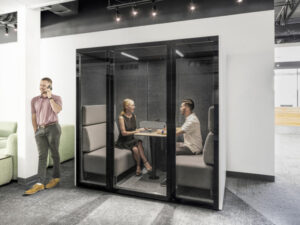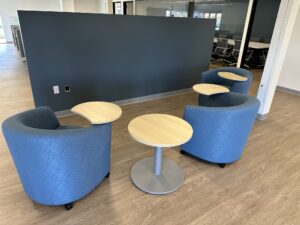18 Dec Designing Harmonious Workspaces: Balancing Collaboration and Privacy
Achieving Collaboration and Privacy…Balance is Possible
When it comes to designing office spaces, there are two crucial elements that need to be considered: collaboration and privacy. Collaboration fosters creativity, teamwork, and idea-sharing, while privacy is essential for focused work and maintaining confidentiality. Striking the right balance between these two elements is key to creating harmonious workspaces that promote optimal productivity and employee satisfaction. In this post, we will explore the importance of office design in promoting collaboration and privacy and discuss various strategies to achieve this balance.

The Benefits of Collaboration in the Workplace
 Collaboration is a powerful tool that can lead to increased innovation and productivity. When employees work together, they can leverage their diverse skills, knowledge, and perspectives to solve complex problems and generate innovative ideas. Collaborative office spaces, such as open-plan layouts, open workstations and accessible benching areas encourage spontaneous interactions and facilitate communication among team members. This fosters a sense of belonging, camaraderie, and teamwork, enhancing employee engagement and job satisfaction.
Collaboration is a powerful tool that can lead to increased innovation and productivity. When employees work together, they can leverage their diverse skills, knowledge, and perspectives to solve complex problems and generate innovative ideas. Collaborative office spaces, such as open-plan layouts, open workstations and accessible benching areas encourage spontaneous interactions and facilitate communication among team members. This fosters a sense of belonging, camaraderie, and teamwork, enhancing employee engagement and job satisfaction.
The Drawbacks of Excessive Collaboration
While collaboration is beneficial, it is important to recognize that excessive collaboration can have its drawbacks. Constant interruptions and distractions can hinder individual productivity and focus. Employees may struggle to find quiet spaces to concentrate on complex tasks or engage in confidential conversations. Moreover, some employees may feel overwhelmed by the constant need for collaboration and prefer more solitude to recharge and reflect. Therefore, it is crucial to strike a balance between collaboration and privacy in office design.
The Importance of Privacy in the Workplace
 Privacy is essential for employees to perform focused work, engage in confidential discussions, and maintain a sense of personal space. It allows individuals to concentrate, think creatively, and solve problems without distractions. Additionally, privacy provides employees with a sense of autonomy and control over their work environment, leading to increased job satisfaction and overall well-being. Providing spaces that allow for personal, undistracted times inside of the office is critical. Areas such as “phone booths” or other privacy options is a great start. If your space is “too open” but structural changes are not an option, strategic additions using architectural walls can be an easy and attractive solution. Designing office spaces that prioritize privacy helps create an environment where employees can thrive and reach their full potential.
Privacy is essential for employees to perform focused work, engage in confidential discussions, and maintain a sense of personal space. It allows individuals to concentrate, think creatively, and solve problems without distractions. Additionally, privacy provides employees with a sense of autonomy and control over their work environment, leading to increased job satisfaction and overall well-being. Providing spaces that allow for personal, undistracted times inside of the office is critical. Areas such as “phone booths” or other privacy options is a great start. If your space is “too open” but structural changes are not an option, strategic additions using architectural walls can be an easy and attractive solution. Designing office spaces that prioritize privacy helps create an environment where employees can thrive and reach their full potential.
Striking the Right Balance Between Collaboration and Privacy
To create a harmonious workspace, it is important to strike the right balance between collaboration and privacy. This can be achieved by implementing office design strategies that cater to diverse needs and preferences. One approach is to incorporate both open and closed spaces within the office layout. Open areas can serve as collaborative zones, equipped with comfortable seating, interactive whiteboards, and shared resources. Closed spaces, such as meeting rooms or private cubicles, can provide employees with the privacy they need for focused work or confidential discussions.
Office Design Strategies to Promote Collaboration
To promote collaboration, office design can incorporate elements such as open-plan layouts, shared communal areas, and collaborative tools and technologies. By creating spaces that encourage spontaneous interactions and idea-sharing, organizations can foster a culture of collaboration. Additionally, providing employees with access to resources and tools that facilitate collaboration, such as video conferencing systems or project management software, can further enhance teamwork and productivity.
Office Design Strategies to Promote Privacy
 To promote privacy, office design can include designated quiet zones, individual workstations, and sound masking measures. These spaces offer employees the solitude they need to concentrate on complex tasks or engage in confidential conversations. Utilizing sound-absorbing materials, such as carpets or acoustic panels, can help minimize noise distractions and create a more private environment. Additionally, providing employees with adjustable screens or dividers can offer them the flexibility to control their level of privacy as per their needs.
To promote privacy, office design can include designated quiet zones, individual workstations, and sound masking measures. These spaces offer employees the solitude they need to concentrate on complex tasks or engage in confidential conversations. Utilizing sound-absorbing materials, such as carpets or acoustic panels, can help minimize noise distractions and create a more private environment. Additionally, providing employees with adjustable screens or dividers can offer them the flexibility to control their level of privacy as per their needs.
Creating Flexible Workspaces that Cater to Different Needs
One size does not fit all when it comes to office design. Recognizing that different employees have different preferences and work styles, it is essential to create flexible workspaces that cater to these diverse needs. This can be achieved by offering a variety of workstations, such as standing desks, quiet pods, or collaboration hubs. Providing employees with the ability to choose their preferred work setting allows them to optimize their productivity and well-being, ultimately leading to higher job satisfaction and retention.
Case Study of Collaboration and Privacy Balance
 One of our clients, Bright Peak Therapeutics, is a fantastic example of achieving a healthy balance between collaboration and privacy. We collaborated with them to develop a space plan for their new office space that allowed for both goals to be achieved. Even in a space where private rooms cannot be achieved because of building construction, proper design layout can still create privacy as their example demonstrates. Further, collaboration areas are not just implied, rather they are overtly incorporated into the design and the types of office furniture obtained for these areas clearly communicate intent. Please see the implementation of this design approach in our client highlight.
One of our clients, Bright Peak Therapeutics, is a fantastic example of achieving a healthy balance between collaboration and privacy. We collaborated with them to develop a space plan for their new office space that allowed for both goals to be achieved. Even in a space where private rooms cannot be achieved because of building construction, proper design layout can still create privacy as their example demonstrates. Further, collaboration areas are not just implied, rather they are overtly incorporated into the design and the types of office furniture obtained for these areas clearly communicate intent. Please see the implementation of this design approach in our client highlight.
Bottom Line
 In conclusion, designing harmonious workspaces that balance collaboration and privacy is crucial for promoting optimal productivity and employee satisfaction. By considering the benefits of collaboration, the drawbacks of excessive collaboration, the importance of privacy, and implementing appropriate office design strategies, organizations can create an environment where employees can thrive.
In conclusion, designing harmonious workspaces that balance collaboration and privacy is crucial for promoting optimal productivity and employee satisfaction. By considering the benefits of collaboration, the drawbacks of excessive collaboration, the importance of privacy, and implementing appropriate office design strategies, organizations can create an environment where employees can thrive.
MyOffice has over 20 years of experience in supporting client’s implementing office solutions. We understand the needs of the modern office environment, one that has been dominated by the “open floor plan” for the past 20+ years. We understand how to combine a design layout with creative furniture solutions to achieve a workable balance of collaboration and privacy. Contact us to explore tailored solutions for your office so you too can achieve that balance!

Creating a harmonious office space that balances collaboration and privacy is a worthy objective. A goal that is fully achievable through professional layout design and expert furnishings advice. Connecting with an industry expert to understand options is the first step to creating a workspace where employees will thrive. If you need assistance with office design and furniture solutions, or any other office environment concern, we make it easy to address….
